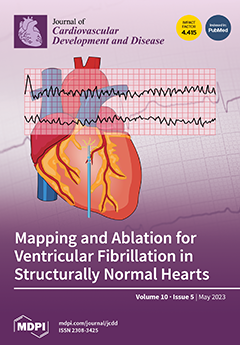Introduction: Persistent coronary microcirculatory dysfunction (CMD) and elevated trimethylamine N-oxide (TMAO) levels after ST-elevation myocardial infarction (STEMI) may drive negative structural and electrical cardiac remodeling, resulting in new-onset atrial fibrillation (AF) and a decrease in left ventricular ejection fraction (LVEF). Aims: TMAO and
[...] Read more.
Introduction: Persistent coronary microcirculatory dysfunction (CMD) and elevated trimethylamine N-oxide (TMAO) levels after ST-elevation myocardial infarction (STEMI) may drive negative structural and electrical cardiac remodeling, resulting in new-onset atrial fibrillation (AF) and a decrease in left ventricular ejection fraction (LVEF). Aims: TMAO and CMD are investigated as potential predictors of new-onset AF and left ventricular remodeling following STEMI. Methods: This prospective study included STEMI patients who had primary percutaneous coronary intervention (PCI) followed by staged PCI three months later. Cardiac ultrasound images were obtained at baseline and after 12 months to assess LVEF. Coronary flow reserve (CFR), and index of microvascular resistance (IMR) were assessed using the coronary pressure wire during the staged PCI. Microcirculatory dysfunction was defined as having an IMR value ≥25 U and CFR value <2.5 U. Results: A total of 200 patients were included in the study. Patients were categorized according to whether or not they had CMD. Neither group differed from the other with regards to known risk factors. Despite making up only 40.5% of the study population, females represented 67.4% of the CMD group
p < 0.001. Similarly, CMD patients had a much higher prevalence of diabetes than those without CMD (45.7% vs. 18.2%;
p < 0.001). At the one-year follow-up, the LVEF in the CMD group had decreased to significantly lower levels than those in the non-CMD group (40% vs. 50%;
p < 0.001), whereas it had been higher in the CMD group at baseline (45% vs. 40%;
p = 0.019). Similarly, during the follow-up, the CMD group had a greater incidence of AF (32.6% vs. 4.5%;
p < 0.001). In the adjusted multivariable analysis, the IMR and TMAO were associated with increased odds of AF development (OR: 1.066, 95% CI: 1.018–1.117,
p = 0.007), and (OR: 1.290, 95% CI: 1.002–1.660,
p = 0.048), respectively. Similarly, elevated levels of IMR and TMAO were linked with decreased odds of LVEF improvement, while higher CFR values are related to a greater likelihood of LVEF improvement. Conclusions: CMD and elevated TMAO levels were highly prevalent three months after STEMI. Patients with CMD had an increased incidence of AF and a lower LVEF 12 months after STEMI.
Full article






